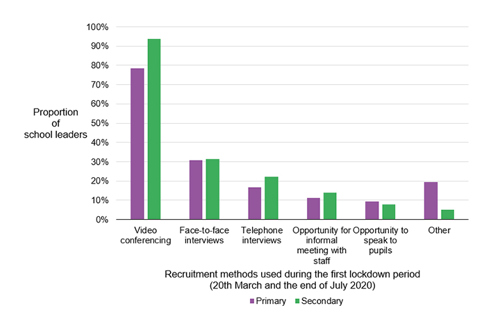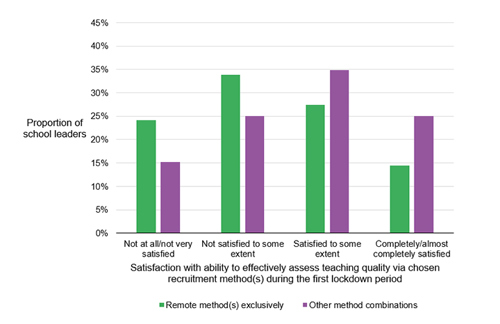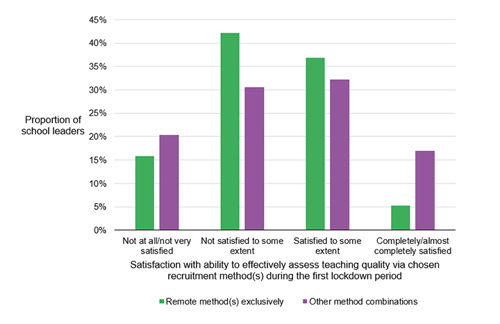How satisfied have schools been with recruiting teachers remotely?
Tuesday 15 June 2021
 In the first of a series of blogs on Covid-19 and the teacher workforce, NFER Research Manager Megan Lucas looks at schools’ experiences of recruiting teachers in 2020.
In the first of a series of blogs on Covid-19 and the teacher workforce, NFER Research Manager Megan Lucas looks at schools’ experiences of recruiting teachers in 2020.
The onset of the Covid-19 pandemic brought with it profound changes in how schools were able to recruit teachers. Schools were faced with the challenging task of adapting their recruitment processes to comply with Covid-19 restrictions, while maintaining their ability to appropriately assess candidates and find the right candidate for their school. In practice, this resulted in the vast majority of schools recruiting remotely, at least in part and often for the first time, for a prolonged period in spring and summer 2020. A key concern schools grappled with was around how this would impact their ability to effectively assess the teaching quality of candidates.
Recent data from an NFER survey of school leaders, conducted last autumn, provides new insights into how schools recruited during the first lockdown period (March-July 2020), how satisfied school leaders were with their ability to effectively assess teaching quality using this process, and lessons school leaders might learn from these experiences as they recruit for the new academic year.
Around half of schools used exclusively remote methods to recruit during this period
Overall, 56 per cent of secondary school leaders and 49 per cent of primary leaders who attempted to recruit during this period reported only using remote methods (that is, video conferencing, telephone interviewing or both) to recruit teachers during the lockdown period. As Figure 1 shows, the majority of school leaders used video conferencing as part of their recruitment process. Among secondary school leaders, 94 per cent reported using video conferencing compared to 78 per cent of primary school leaders. It appears that schools have broadly opted to use this rather than telephone interviews, which were used by only 18 per cent of all schools.
In contrast, the use of face-to-face interviews, which prior to the pandemic would have been a core part of the recruitment process, appears greatly reduced – around 30 per cent of leaders in primary and secondary schools continued using face-to-face interviews. That said, the finding that almost a third of school leaders continued with face-to-face interviews is quite surprising. Between March 20th and 31st May, schools were only open to vulnerable children, the children of keyworkers and the staff required to appropriately care for them each day. All others were asked to stay away from the school site. It may be that the schools who used face-to-face interviews were also the schools who delayed their recruitment process until later in the term, coinciding with the period in June when schools began to reopen to more pupils, school staff became eligible for testing and schools started implementing safety measures following guidance from the Department for Education.
Figure 1: The proportion of school leaders who used face-to-face interviews reduced greatly while video conferencing was used by the majority of leaders

Satisfaction with their ability to effectively assess teaching quality was lower among senior leaders who used exclusively remote methods, compared to those who used other methods
We asked school leaders about their satisfaction with their ability to effectively assess teaching quality via the interviewing process they used during the first lockdown period (March-July 2020), on a scale of 1 to 8 where 1 represents ‘not at all satisfied’ and 8 represents ‘completely satisfied’. The results show that satisfaction levels were relatively low during this period, in terms of school leaders’ ability to assess the teaching quality of candidates. The mean satisfaction rating was just 4.3 for secondary school leaders and 4.5 for primary school leaders.
As shown in Figure 2 below, satisfaction levels were lower for school leaders relying exclusively on remote methods (that is, video conferencing, telephone interviewing or both) than leaders using other methods. Among primary school leaders, less than 15 per cent of leaders using only remote methods were completely or almost completely satisfied compared to 25 per cent among leaders using other methods. Similarly, just 5 per cent of secondary school leaders relying on remote methods reported being completely or almost completely satisfied compared to 17 per cent less among leaders using other methods. Interestingly, secondary school leaders using other methods appear more likely to be not at all or not very satisfied than leaders using remote methods, although this is a non-significant trend.
Figure 2: Primary school leaders using remote recruitment methods were less satisfied with their ability to assess teaching quality than leaders using other methods

Figure 3: Secondary school leaders using remote recruitment methods were less satisfied with their ability to assess teaching quality than leaders using other methods

The results show that, while schools were able to continue recruiting during this period, often relying on telephone interviews and/or video conferencing to facilitate their recruitment, these adapted recruitment processes did not entirely satisfy the needs of school leaders in terms of assessing the quality of their candidates.
What does this mean for school leaders recruiting now?
As the pandemic and the associated restrictions continue into the summer term, schools are once again recruiting in challenging circumstances. The latest guidance from the Department for Education is clear that schools should continue to adopt a flexible approach to recruitment, which utilises alternatives to face-to-face interviews where possible. That said, there are key differences to the context now compared to summer 2020, which may be important for leaders finding a recruitment process which they feel best satisfies their need to assess candidate teaching quality. For example, infection rates nationally are far lower, schools are now fully open, schools are more experienced at operating in a Covid-secure manner and Covid-19 tests are widely available nationally, with pupils and staff expected to regularly test themselves.
Perhaps most importantly, schools are now able to have visitors on-site and hold face-to-face meetings when necessary, provided that the appropriate safety measures are in place. This means that schools have the ability to incorporate face-to-face recruitment activities where they deem it essential. School leaders currently using an exclusively remote method who feel highly dissatisfied with their ability to assess quality may wish to consider how face-to-face activities can be used selectively alongside their remote activities to improve their satisfaction with the recruitment process.
Of course, some schools and candidates will prefer to continue recruiting entirely remotely as the pandemic persists. Therefore, schools should also consider how they might add additional layers and variety to their remote recruiting activities in order to better assess teaching quality. For example, now that most teachers have built up to a year of experience teaching online, schools could consider asking candidates to deliver an online lesson. Arranging a variety of activities that can be delivered remotely, in addition to an interview, may help school leaders to more effectively understand and assess the quality of teaching on offer amongst candidates, overcoming some of the limitations of remote recruitment methods.
